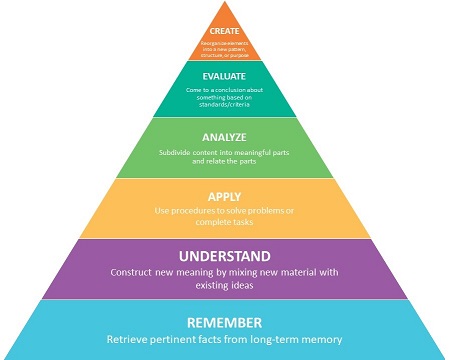
Learning outcomes are goals for student learning that you, as the instructor, set for your course. They essentially answer the question "What will students learn?" Course-level or semester-long learning outcomes are usually shared with students in the syllabus. You can also write learning outcomes for each unit or chapter, or even each class meeting; use them as a guide as you design the course, and share them with students to guide their studying.
Over all, learning outcomes:
Learning outcomes demonstrate what you want students to know, do, or value by the end of your course. A typical learning outcome may start with "By the end of this course, students will be able to…" Then, continue the sentence with an action verb and a goal for the course. When writing learning outcomes, Bloom's Taxonomy (described below) can be a helpful tool to choose action verbs that reflect the appropriate level of rigor intended for the course.
Bloom's Taxonomy is a tool to help you to assess the level of rigor and challenge your students are experiencing in your course. To consciously and intentionally address the level of cognitive complexity and challenge in a course, Bloom's Taxonomy is an excellent framework, providing multiple points of entry.
The cognitive domain concerns knowledge (remembering/retaining information) and the development of intellectual skills (synthesis, problem solving, etc.). The different levels of the cognitive domain categorize students' thinking from less to more complex levels of thinking; for example, having students write a paper analyzing the impact of interest rates on the growth of the U.S. economy requires substantially more complex thinking than asking students to state the current interest rate. There are six major categories of cognitive processes, starting from simple to more complex processes:

Instructors can use the six major categories to organize their lesson plans and assignments into varying levels of difficulty, resulting in a course that guides students through increasingly more complex material. Additionally, instructors can use the verbs associated with Bloom's taxonomy to develop clear learning objectives associated with a specific level of difficulty. Building learning objectives using Bloom's cognitive taxonomy can help instructors link learning activities with specific levels of complexity.
This Bloom's Taxonomy resource show the cognitive levels of the pyramid with sample verbs associated with each level for easily creating learning outcomes or exam questions.
The affective domain demonstrates how new knowledge and learning promotes the growth in a student's feelings or emotions such as values, motivations, and attitudes. Students encounter the world through their affective domain via their values and belief systems: the outward portrayal of the affective domain would be the student's attitude. A student's attitude can have a profound effect on his or her learning. For example, a student may have competency in performing a task, but may not have the desire (attitude). People in general change their attitude in response to various events in life; however, instructors can change a student's affective domain over the course of a class by performance interventions.
For more information about the affective domain taxonomy, including examples and key words/verbs for each level, visit Bloom's Taxonomy: Affective Domain.
The psychomotor domain relates to the physical movement, coordination, and use of motor skills involved in completing a task or learning new material. Students learn how to physically accomplish tasks through the psychomotor domain by applying strategy and practicing performing the actions required. Students improve their skill by choosing and implementing the most efficient strategies to accomplish the task, reviewing the results, and then refining their strategies.
To learn more about the psychomotor domain taxonomy, including examples and key words/verbs for each level, visit Bloom's Taxonomy: Psychomotor Domain.
The Bloom's Taxonomy with which you may be familiar (shown above) is actually a version that was revised in 2001 1 of the original 1959 taxonomy 2 . To learn more about the revision, see Bloom's Taxonomy Revised.
This 11 minute video created by John Hopkins introduces instructors to using Bloom's Taxonomy to create learning objectives.
1 Anderson, L. W. and Krathwohl, D. R., et al (Eds..) (2001) A Taxonomy for Learning, Teaching, and Assessing: A Revision of Bloom's Taxonomy of Educational Objectives. Allyn & Bacon. Boston, MA: Pearson Education Group.
2 Bloom, B.S. and Krathwohl, D. R. (1956) Taxonomy of Educational Objectives: The Classification of Educational Goals, by a committee of college and university examiners. Handbook I: Cognitive Domain. NY, NY: Longmans, Green.